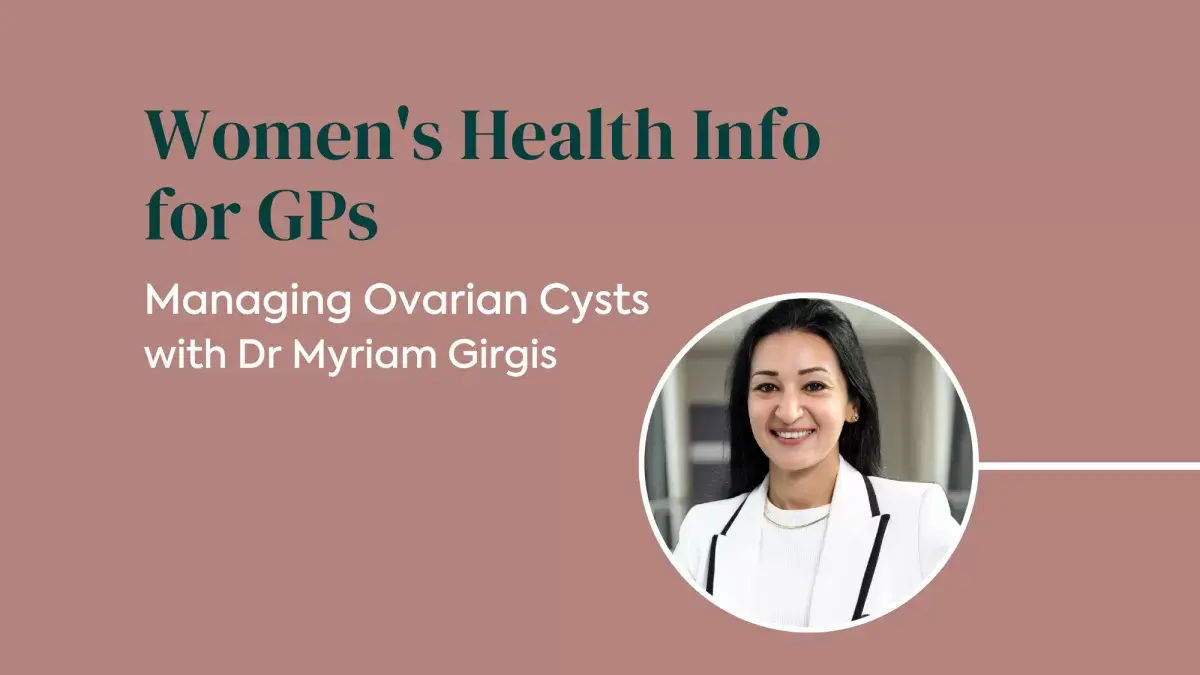- Medical Careers
- 6 min read
Women’s Health info for GPs
Consultant Obstetrician Gynaecologist Dr Myriam Girgis shares her insight on shared care of patients with ovarian dermoid cysts
- By: Admin
- September 27, 2024

Based in Sydney, Specialist Obstetrician, Gynaecologist and Advanced Endoscopic Pelvic Surgeon Dr Myriam Girgis, shares her expert insights on early detection, appropriate management, and optimal care for patients with ovarian dermoid cysts. With an interest in high-risk pregnancy, and complex gynaecological surgery for endometriosis and pelvic pain, Dr Girgis is a clinical educator, mentor of specialist juniors, specialist interview panelist and RANZCOG examiner, who has designed this information for GPs interested in learning about the management of gynaecological pathologies in primary care settings.
What are ovarian dermoid cysts and how common are they?
Ovarian dermoid cysts, also known as mature cystic teratomas, are the most common type of benign ovarian tumour, accounting for approximately 60% of all benign ovarian tumours. They are most commonly found in patients between the ages of 20 and 40. While they are typically unilateral, around 10-17% of cases are bilateral dermoid cysts. Large and/or bilateral dermoid cysts are more likely to affect fertility.
What are the clinical presentations of dermoid cysts?
Patients with dermoid cysts may experience abdominal enlargement and pain if the cysts rupture, leading to the spillage of sebaceous material into the abdominal cavity. Other possible clinical presentations include adnexal torsion (twisting of the ovary), which occurs in up to 15% of cases, and bowel obstruction.
How are dermoid cysts diagnosed and are there specific markers to consider?
Diagnosis involves a pelvic ultrasound, which is the first-line imaging modality for assessing adnexal masses. If the features on ultrasounds are inconclusive, further evaluation with CT or MRI may be necessary. Serum tumour markers may also be elevated in dermoid cysts. They are composed of mature differentiated tissue that originates from three germ cell layers: ectoderm, mesoderm, and endoderm. These cysts macroscopically appear as a mass containing of hair, teeth, and/or skin, along with thick sebaceous material.
How are dermoid cysts managed?
The management approach depends on various factors, including symptoms, age, tumour size, tumour markers, imaging feature, fertility plans and personal preference. Asymptomatic young patients with small, benign-appearing dermoid cysts and normal tumour markers may opt for cyst surveillance as a first-line approach. However, symptomatic patients often choose surgery. Ovarian cystectomy is recommended for reproductive-age women with fertility plans. For women who have completed childbearing, salpingo-oophorectomy (removal of the affected ovary and fallopian tube) is a viable option. The removal of mature cystic teratomas can be performed via laparoscopy or laparotomy, depending on the size of the cyst and other considerations.
What is the prognosis for dermoid cysts?
The recurrence rate for mature cystic teratomas is approximately 3-4%. There are three main predictive factors for teratoma recurrence after surgical excision: bilateral tumours, young age (under 30 years) and tumour size larger than 8 cm.
Is there a risk of malignant transformation in dermoid cysts?
Malignant transformation can occur in 1-3% of cases. It can develop in any of the tissue components within a mature cystic teratoma, with squamous cell carcinoma transformation accounting for approximately 80% of cases. Risk factors for malignant neoplasms in dermoid cysts include being aged over 45 years, a mass diameter larger than 10 cm, rapid growth, and suspicious findings on imaging.
Dermoid cysts, the most common primary ovarian tumours, can present with various clinical manifestations and require careful management. As Dr Girgis notes, awareness of diagnosis, surgical options, prognosis, and the risk of malignant transformation is crucial for effective patient care and decision-making.
Download the NSW WLHD Ovarian Dermoid Fact Sheet here.
Related Articles
-
 Jun 12
Jun 12Dr Judy's Grand Tour: Tales from a Locum GP Adventurer!
Go behind the scenes with locum GP Dr Judy as she shares her incredible travels & practical tips from nearly 20 placements across Australia.
- Discover Regional Australia
- rural healthcare
- General Practice
- Locum doctor
- Wavelength
- 3 min read
-
 Aug 1
Aug 1The rewarding and fulfilling experiences of AMS locum work
This NAIDOC Week, Dr Kirsten Due shares her experiences providing essential healthcare and fostering meaningful connections in some of Australia’s most remote Indigenous communities.
- Medical Careers
- Admin
- 6 min read
-
 Sep 27
Sep 27The Future of General Practice
In the middle of a GP shortfall, medical students across the nation share their solutions on attracting more doctors to take up general practice.
- News
- Medical Careers
- Admin
- 6 min read
Related Programs
-
 Jun 12
Jun 12Dr Judy's Grand Tour: Tales from a Locum GP Adventurer!
Go behind the scenes with locum GP Dr Judy as she shares her incredible travels & practical tips from nearly 20 placements across Australia.
- Discover Regional Australia
- rural healthcare
- General Practice
- Locum doctor
- Wavelength
- 3 min read
-
 Aug 1
Aug 1The rewarding and fulfilling experiences of AMS locum work
This NAIDOC Week, Dr Kirsten Due shares her experiences providing essential healthcare and fostering meaningful connections in some of Australia’s most remote Indigenous communities.
- Medical Careers
- Admin
- 6 min read
-
 Sep 27
Sep 27The Future of General Practice
In the middle of a GP shortfall, medical students across the nation share their solutions on attracting more doctors to take up general practice.
- News
- Medical Careers
- Admin
- 6 min read
